Sculpture on the High Seas
by Bob Brooke
Sometimes referred to as
"Neptune's wooden angels," ships’ figureheads have been in use since
antiquity. As the popularity of wooden boats waned in the 19th century,
so too did the popularity of wooden figureheads. New forms of
transportation and ornamentation replaced wooden ships and figureheads
began to appear in galleries and museums.
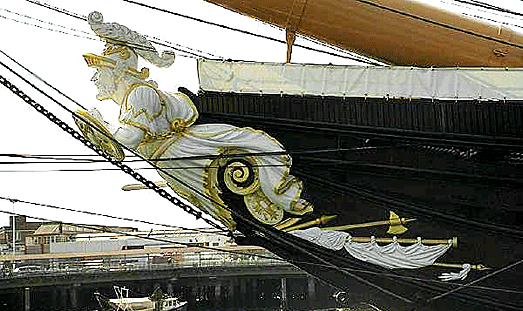
The Origins of Ships’ Figureheads
While the origins of ships’ figureheads are somewhat obscure, historians
believe that seafarers placed the head of an animal sacrificed as an
offering to the gods on board to guarantee a safe journey. Sailors
eventually placed these heads at the bow of the ship where their eyes
could keep a lookout ahead.
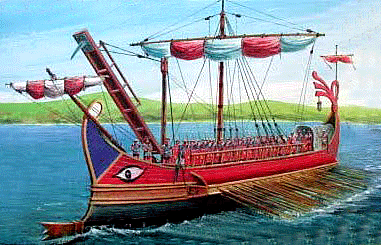 Earlier
ships often had some form of bow ornamentation, such as the eyes the
Phoenicians and Greeks painted on the bows of their ships and the Roman
practice of putting carvings of their deities on the bows of their
galleys. The Egyptians placed figures of holy birds on the prow while
the Phoenicians used horses representing speed. The Ancient Greeks used
boars' heads to symbolize acute vision and ferocity while Roman boats
often mounted a carving of a centurion representing valor in battle. Earlier
ships often had some form of bow ornamentation, such as the eyes the
Phoenicians and Greeks painted on the bows of their ships and the Roman
practice of putting carvings of their deities on the bows of their
galleys. The Egyptians placed figures of holy birds on the prow while
the Phoenicians used horses representing speed. The Ancient Greeks used
boars' heads to symbolize acute vision and ferocity while Roman boats
often mounted a carving of a centurion representing valor in battle.
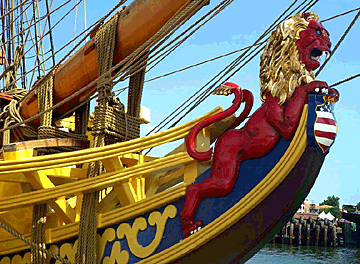 Eventually
carved animal figures appeared at the bow of most ships. In northern
Europe, serpents, bulls, dolphins and dragons were customary and by the
13th Century, the swan represented grace and mobility. But it was the
galleons of the 16th century that introduced ships’ figureheads to
shipping. Before that ships didn’t have an actual stemhead structure on
which to place them. Eventually
carved animal figures appeared at the bow of most ships. In northern
Europe, serpents, bulls, dolphins and dragons were customary and by the
13th Century, the swan represented grace and mobility. But it was the
galleons of the 16th century that introduced ships’ figureheads to
shipping. Before that ships didn’t have an actual stemhead structure on
which to place them.
Sculptures of lions, unicorns, and dragons remained popular as
figureheads in England until the 17th century, at which point larger
ships began to be fitted with life-sized ships’ figureheads of horses
being ridden by the members of royalty the ship had been named after.
Trends quickly changed to include group figureheads with sculptures of
knights in armor and double headed horses.
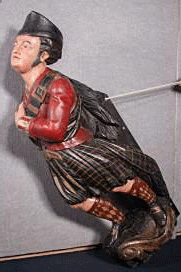 By
the 1760s animals had gone out of style and human figures representing
ships’ names or otherwise symbolic became popular. Throughout the period
of wooden sailing vessels nearly every ship had a figurehead mounted on
its prow. Some sailors even believed that voyage on a craft without a
figure could be fatal. By
the 1760s animals had gone out of style and human figures representing
ships’ names or otherwise symbolic became popular. Throughout the period
of wooden sailing vessels nearly every ship had a figurehead mounted on
its prow. Some sailors even believed that voyage on a craft without a
figure could be fatal.
In Germany, Belgium and the Netherlands, seafarers once believed that
spirits or faeries called Kaboutermannekes lived in the figureheads. The
spirit guarded the ship from sickness, rocks, storms, and dangerous
winds. If the ship sank, the Kaboutermannekes guided the sailors' souls
to the Land of the Dead. Dutch sailors believed to sink without a
Kaboutermanneke condemned their souls to haunt the sea forever. Early
Vikings believed this, also.
At the height of the Baroque era, some ships boasted gigantic
figureheads weighing several tons and sometimes duplicated on both sides
of the bowsprit. It was common for high-ranking ships to be decorated
with elaborately designed groups of carvings. These sculptures, which
included figures such as gods, goddesses, monarchs, putti, horses,
winged horses, and mermaids, were often life-sized and full of symbolism
for the fleet to which the ship belonged. Charles Le Brun, Jean Berain,
and Pierre Puget are some of the most notable ship artists from this
period and decorated ships that largely occupied the Mediterranean ports
of Marseilles and Toulon.
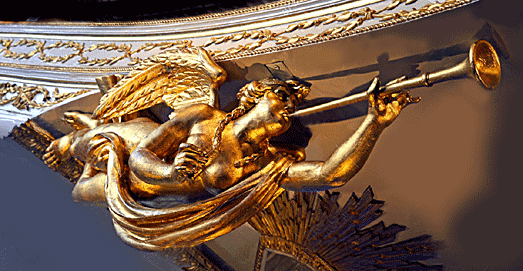
A large figurehead, being
carved from massive wood and perched on the very foremost tip of the
hull, adversely affected the sailing qualities of the ship. This and the
high cost led ship builders to commission smaller figureheads during the
18th century. Some ship builders stopped using them altogether around
1800. After the Napoleonic wars they made something of a comeback, but
were then often in the form of a small waist-up bust rather than the
oversized full figures previously used. The clipper ships of the 1850s
and 1860s customarily had full figureheads. To make these lighter,
carvers replaced hardwoods with pine. This continued until the era of
wooden ships.
American Figureheads
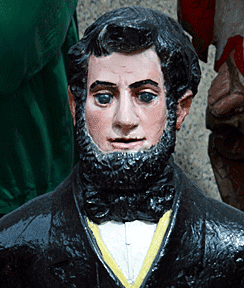 Though
the first American ships’ figureheads were often crude, they were good
examples of their carvers’ pioneering spirit and pride in their new
country. Not only did these folk sculptors carve what they saw but also
what they knew and felt—similar to the folk painters of the era. Every
coastal town along the Atlantic aboard, during the 1700s and 1800s, had
a thriving shipyard where carvers maintained shops, hung out signs and
advertised in papers. Though
the first American ships’ figureheads were often crude, they were good
examples of their carvers’ pioneering spirit and pride in their new
country. Not only did these folk sculptors carve what they saw but also
what they knew and felt—similar to the folk painters of the era. Every
coastal town along the Atlantic aboard, during the 1700s and 1800s, had
a thriving shipyard where carvers maintained shops, hung out signs and
advertised in papers.
Figureheads on steamboats often featured the portraits of U.S.
presidents. Warships had naval heroes and statesmen. John Bellamy,
considered one of the finest folk sculptors, produced fierce eagle
figureheads of pine and gilded them for Navy ships.
Female Figureheads
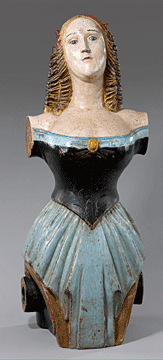 Women
were favorite motifs, reflecting, perhaps, the longing for wives and
sweethearts inevitable on voyages that often lasted several years and
sometimes ended in disaster. Sometimes, the owner of a whaling vessel
would commission a figurehead of his wife or daughter. One known example
shows a woman with her prim straight figure dressed in the long
19th-century dress, her hands tucked neatly in a muff. Fast-sailing
clipper ships usually carried beautiful maidens or Indian princesses. Women
were favorite motifs, reflecting, perhaps, the longing for wives and
sweethearts inevitable on voyages that often lasted several years and
sometimes ended in disaster. Sometimes, the owner of a whaling vessel
would commission a figurehead of his wife or daughter. One known example
shows a woman with her prim straight figure dressed in the long
19th-century dress, her hands tucked neatly in a muff. Fast-sailing
clipper ships usually carried beautiful maidens or Indian princesses.
While most people imagine wenches and mermaids on the prows of sailing
ships, it really wasn’t until the late 18th century that female subjects
began to appear on the bows of ships. Sailor superstition dictated
women, or their effigies, on board, would bring bad luck. As late as
1916, after nearly capsizing, the captain of the vessel Inna Bentley
cast its figurehead of a young girl into the sea. As women became a more
common presence on sea voyages, their figureheads became more common.
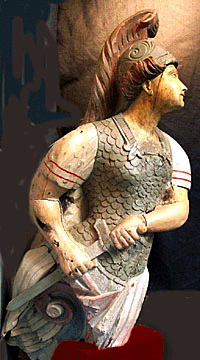 Towards
the end of the 18th century, ships’ carvers began creating full-length,
single figureheads on larger ships and bust portraits on smaller ones.
They carved many of these in the Neoclassic style of the early 19th
century. Mythological figures represented in the carvings were usually
the same as the name of the ship for which it had been created—Apollo,
Zeus, Mars, Mercury, Achilles, Andromeda, Venus, and, naturally Neptune
and Poseidon. Towards
the end of the 18th century, ships’ carvers began creating full-length,
single figureheads on larger ships and bust portraits on smaller ones.
They carved many of these in the Neoclassic style of the early 19th
century. Mythological figures represented in the carvings were usually
the same as the name of the ship for which it had been created—Apollo,
Zeus, Mars, Mercury, Achilles, Andromeda, Venus, and, naturally Neptune
and Poseidon.
Traditionally, sailors
thought of mermaids as sirens, dangerous seductresses whose song could
lure them to shipwreck on coral reefs and rocky coastlines. Oddly,
another myth claimed that a nude or semi-nude woman would calm turbulent
seas. By the mid-19th century, it seems sailors had widely forgotten the
siren myth and instead adopted the bare breasted mermaid figurehead as a
talisman to fair weather. The mermaid eventually became the most common
female figurehead.
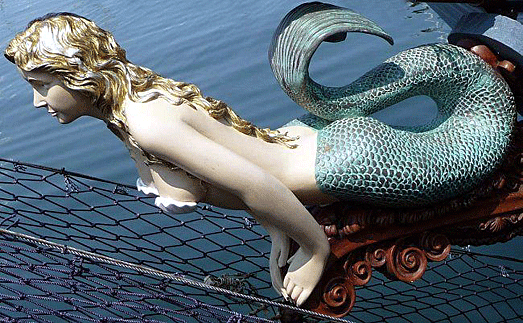
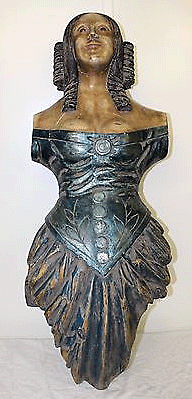 Clothed
women also made popular figureheads in the 19th century. British ships
often carried figures of female royalty like the Queen Victoria figure
commissioned by Junius Smith for his famous paddle steamer British
Queen. The Queen found his likeness of her in her coronation outfit
flattering. Because of her frequent contributions to sailor’s homes and
maritime benevolent institutions, the Swedish songstress Jenny Lind
appeared on over 35 figureheads in the 19th century. Though some sailors
clung to superstitions about women and the ocean, female figureheads
became sailor’s mascots rather than harbingers of bad luck during the
19th century. Clothed
women also made popular figureheads in the 19th century. British ships
often carried figures of female royalty like the Queen Victoria figure
commissioned by Junius Smith for his famous paddle steamer British
Queen. The Queen found his likeness of her in her coronation outfit
flattering. Because of her frequent contributions to sailor’s homes and
maritime benevolent institutions, the Swedish songstress Jenny Lind
appeared on over 35 figureheads in the 19th century. Though some sailors
clung to superstitions about women and the ocean, female figureheads
became sailor’s mascots rather than harbingers of bad luck during the
19th century.
Political Figureheads
Figureheads of prominent political figures often ornamented the bows of
ships. Well-crafted carvings were as important to national prestige as
were well-engineered vessels. Whaling ships like the Thomas Jefferson
and steamer ships like the Abraham Lincoln and the Henry Clay believed
that statues of powerful men would bring them luck and wealth. American
and European naval ships named for or simply hoping to flaunt their most
prominent citizens carried figureheads bearing the likenesses of
politicians and military officers.
The End Finally Had Come
By the mid-19th century, both the role and subject matter of nautical
figureheads had changed dramatically due to the growth of the carving
industry and the decline of wooden shipbuilding. By 1890, most sculptors
relied heavily on show figures for their income. Those in port towns
took to carving life-size wooden Indians and Turks for use outside
tobacco shops.
By 1915, wooden figureheads and shop sculptures alike had fallen almost
completely out of use, but not before modern artists discovered their
value as uniquely American pieces of folk art, representing America's
history.
<
More Special Features
Next Article > |
